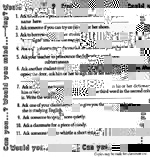The Language Teacher | |||||||||||||||||
QUICK GUIDE Key Words: speaking, pragmatic competence Learner English Level: False Beginner to Advanced Learner Maturity Level: High School to Adult Preparation Time: 5 minutes to make copies Activity Time: 25 minutes (including introduction) Introduction "I want the handout from yesterday." What would you think upon hearing this statement from a student in class? Your first reaction would probably be to grant the request. However, if we examine this speech act beyond its utilitarian function we will begin to question its success. One thing that we can say is that it "gets the job done." The speaker is grammatically competent and the teacher understands what the student wants and needs. However, in terms of pragmatic performance this communicative act is obviously unsuccessful because this student (with no ill will) has made a request in a way that is socially inappropriate. In the above example either the student is unaware of possible ways to soften her request or she is failing to use what she already knows. In the case of requesting, a teacher can help improve a particular student's pragmatic competence by simply explaining the inappropriateness of the speech act at the time it is made and by offering examples of ways the act could have been more polite. Later a whole class activity can be used to reinforce ways one can request politely. Such an activity can be quick and enjoyable as is the activity offered below. This activity focuses on polite requests, particularly the use of the modals would, can, and could. Set-up Make copies of the handout (see Appendix). You will need one for each student in your class. Before class, write the following categories on the blackboard:
Activity
Suggestions The number and variety of examples that you will want to write on the blackboard will depend on the level of your students. If your class is advanced, you will want to explain a variety of ways to soften a request. One possible variation is to include increasingly polite examples for requesting on the blackboard and during the activity students can refuse requests whenever they feel they have not been asked politely enough. The person requesting will then have to try again with a more polite expression. However, if your students are at a basic level, keep the language polite, but simple. Conclusion This activity is lively and fun and can be referred back to when students need to be reminded of ways in which they can make requests more politely.
Article copyright © 1998 by the author. Document URL: http://www.jalt-publications.org/tlt/files/98/oct/sh_galien.html Last modified: November 5, 1998 Site maintained by TLT Online Editor | |||||||||||||||||

